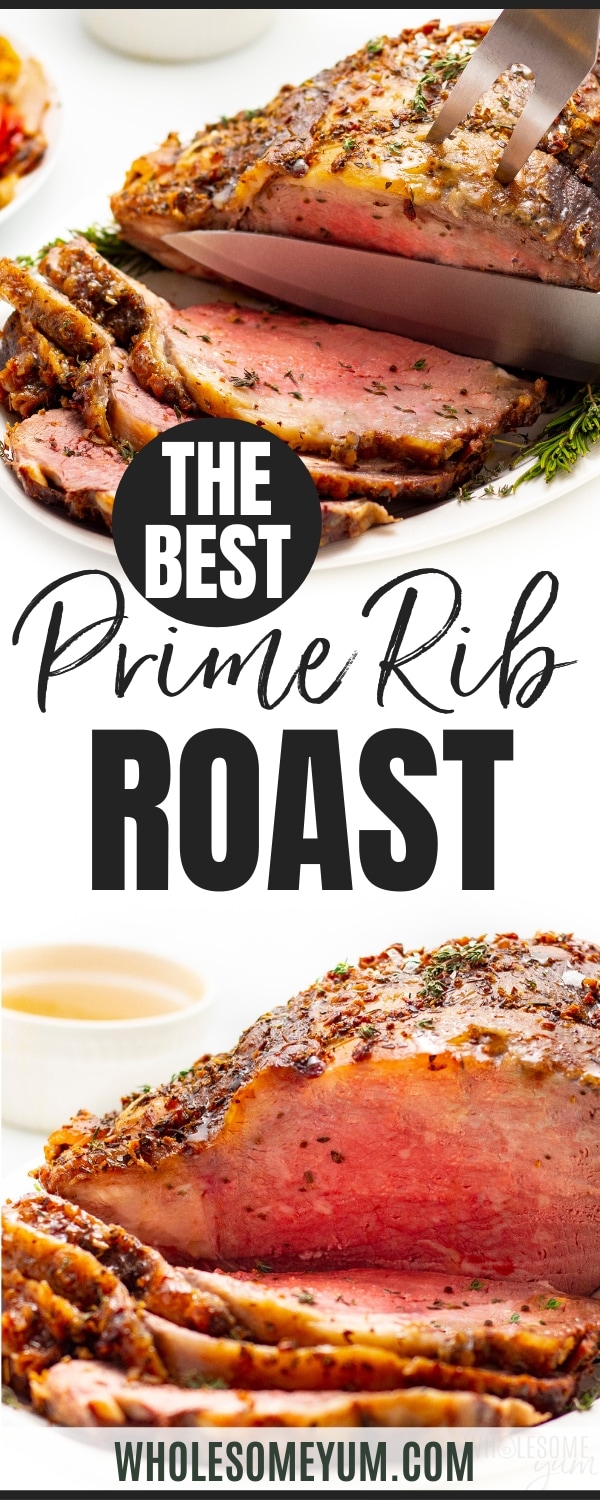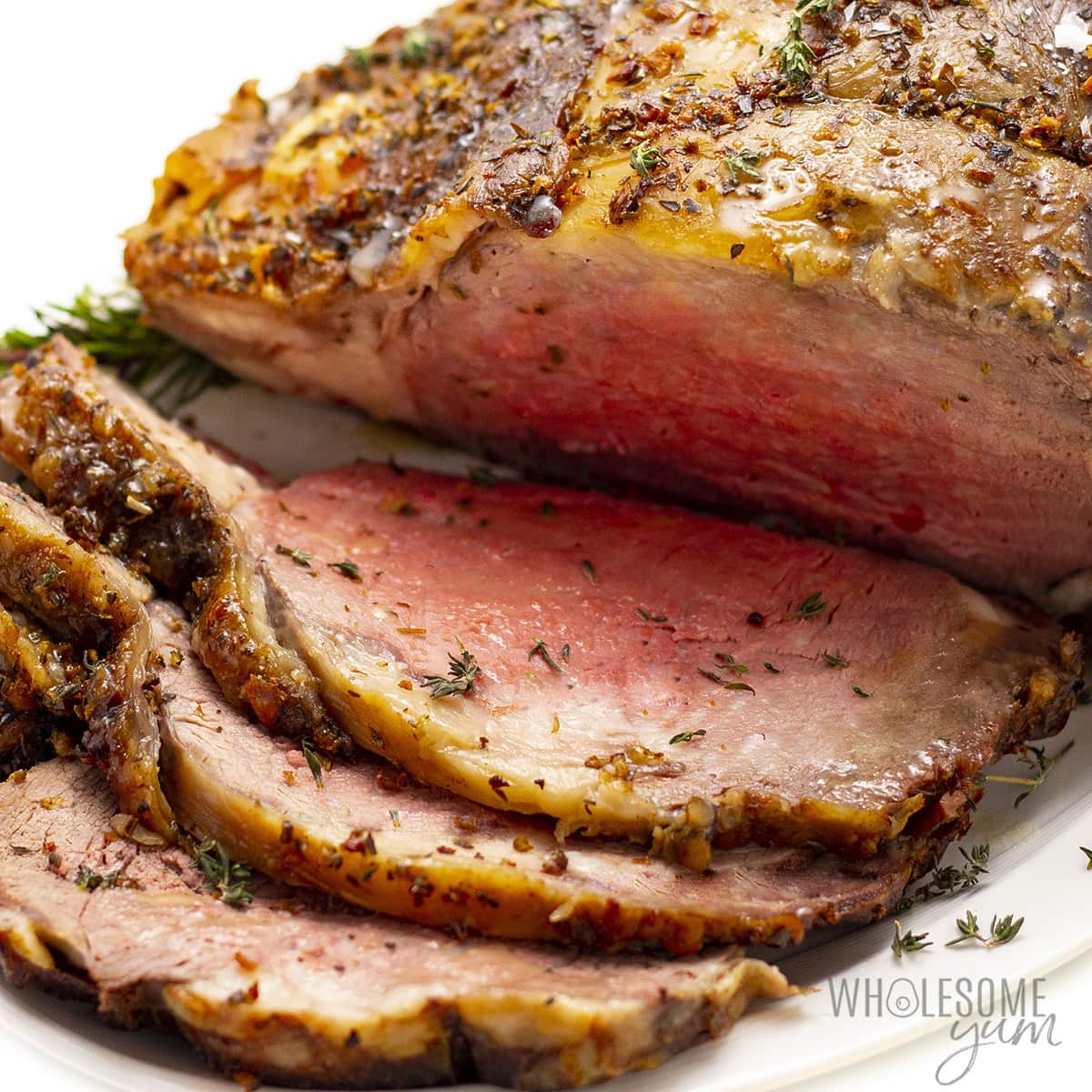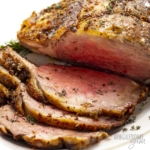Free: 5 Secrets To Fast Healthy Dinners
This post may contain affiliate links, which help keep this content free. (Full disclosure)
Not sure how to cook prime rib? This roasted prime rib recipe is a delicious and special treat that makes the perfect Christmas dinner — or just a fancy dinner for a special event. While cooking prime rib roast may seem like a daunting task, it’s actually quite simple. The key is selecting the perfect cut of meat, seasoning it to perfection, and nailing the cook time.
The garlic butter seasoning makes this the best prime rib roast recipe ever in my book. It’s a type of compound butter that locks in moisture (read: juicy and tender result!) and creates a savory, garlicky flavor. You can also double or triple the compound butter and save it for serving with reverse sear steak or grilled sirloin steak, or use it in recipes like baked chicken thighs and spatchcock chicken.
What Is Prime Rib?
Prime rib is a standing roast beef made from the primal cut of the beef rib. It is well-marbled, meaning it has a higher fat content than other cuts of beef, which makes it juicy and flavorful. The “prime” in prime rib is a grade that is given to meat. The USDA inspectors give grades (prime, choice, select) based on the amount of fat (marbling) and the age of the cow.
Why You’ll Love This Prime Rib Recipe
- Slow roasting makes a perfectly tender and juicy every time
- Starting at high heat creates a golden brown crust
- Savory, garlicky flavor
- Simple ingredients
- Easy 5-minute prep
- Perfect for special occasions
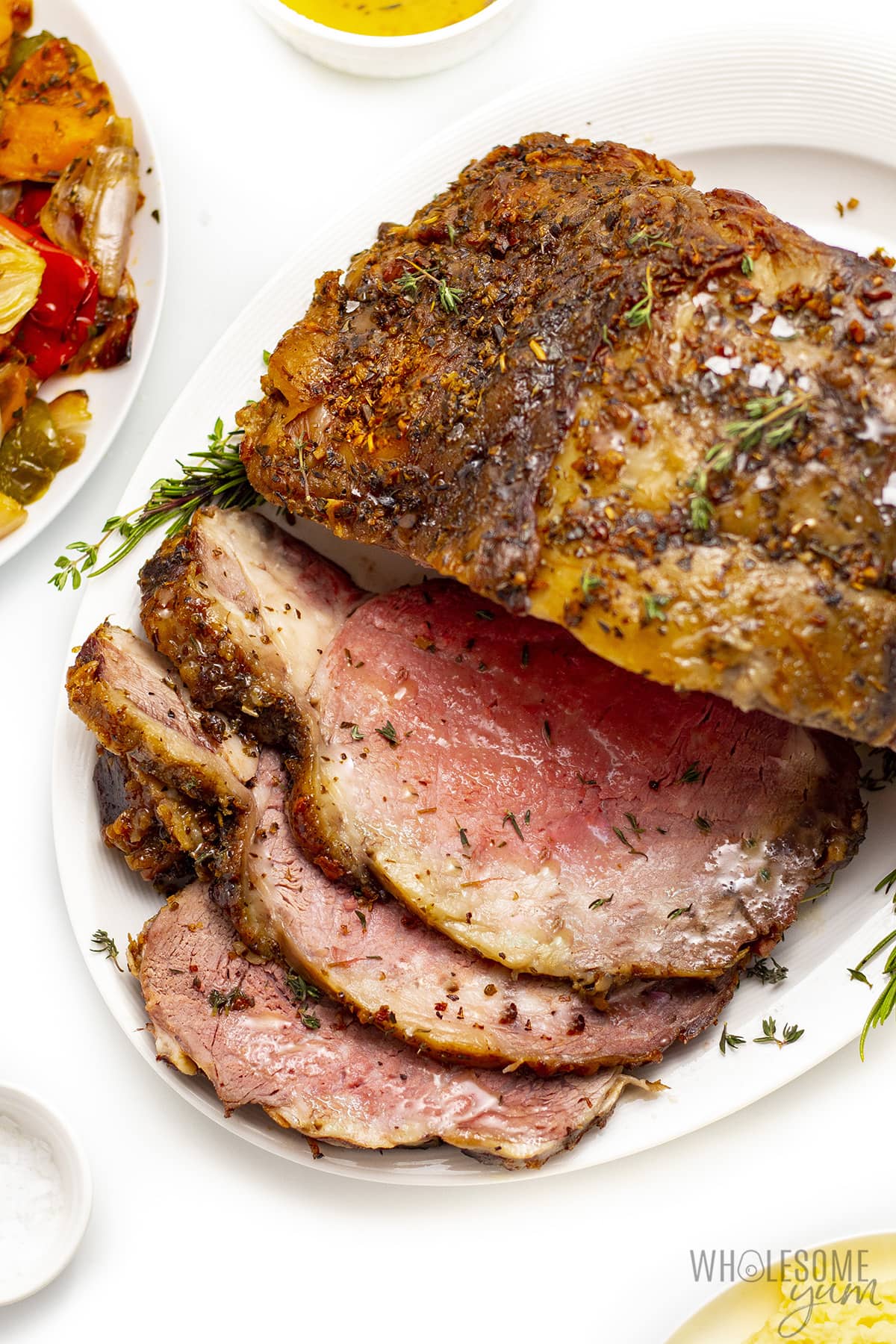
Ingredients & Substitutions
This section explains how to choose the best ingredients for roasted prime rib, what each one does in the recipe, and substitution options. For measurements, see the recipe card below.
Selecting The Prime Rib Roast:
Whenever possible, a bone-in rib roast (sometimes called a standing rib roast) is preferred over a boneless one. Unlike some other cuts of meat, the bones are very easy to remove and result in a much tastier, juicier prime rib recipe for the following reasons:
- The prime rib roast is less likely to dry out. The fat and connective tissue around the bones will break down as the roast cooks, locking in moisture.
- Additional flavor from the bone marrow. Some of the flavor from the bones can actually transfer to the meat as it cooks.
- Bones allow the meat to cook more evenly. Large cuts of meat, such as rib roast, are prone to cooking unevenly since the outside will reach a given temperature sooner than the inside. Bones slow down this process, resulting in more even cooking.
Prime Rib Seasoning:
- Sea Salt – Salt helps to break down the lean muscle proteins in the meat to make it juicier and more tender… and of course adds flavor, too. I always use sea salt in my recipes, but kosher salt will work as well.
- Black Pepper – Use high quality black pepper for the best flavor.
- Unsalted Butter – I like to use unsalted butter so that I can control the amount of salt, but you could also use salted and reduce the salt added separately by 1/4 teaspoon. Melt the butter in the microwave or on the stovetop right before using.
- Italian Seasoning – I used my homemade Italian seasoning mix, but store-bought mixes work as well. You could use dried herbs on their own, like thyme and rosemary, if you prefer. If you opt for fresh herbs instead of dried, triple the amount.
- Garlic – I prefer fresh minced garlic for the best flavor, but you could use jarred minced garlic for convenience. If you choose jarred, use 5-6 teaspoons.
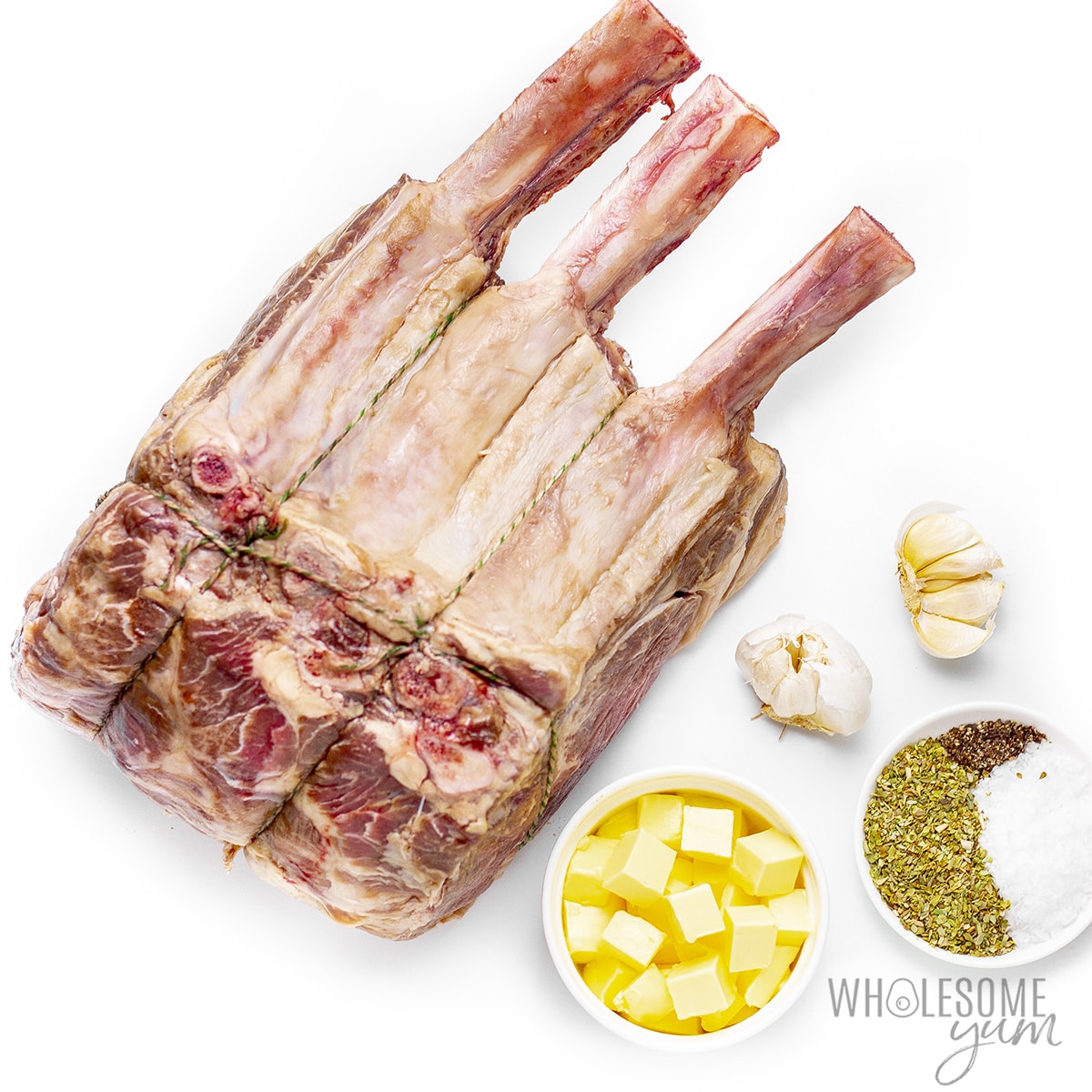
How To Cook A Prime Rib Roast
This section shows how to cook prime rib roast in the oven, with step-by-step photos and details about the technique, to help you visualize it. For full instructions, including amounts and temperatures, see the recipe card below.
- Tie. If your roast is not already tied, tie it tightly with kitchen twine. Your butcher can often do this for you if you ask. If you need to learn how to do it yourself, check my beef tenderloin recipe for a visual. The process is very similar, except there is no tucking involved.
- Dry. Pat the roast dry with paper towels.
- Season. Place the prime rib roast, fatty side up, onto a roasting pan fitted with a roasting rack. Season liberally with sea salt and black pepper. Let it come to room temperature.
- Preheat. Before continuing with the prime rib roast recipe, preheat the oven.
- Stir. In a small bowl, stir together the melted butter, Italian seasoning, and minced garlic.
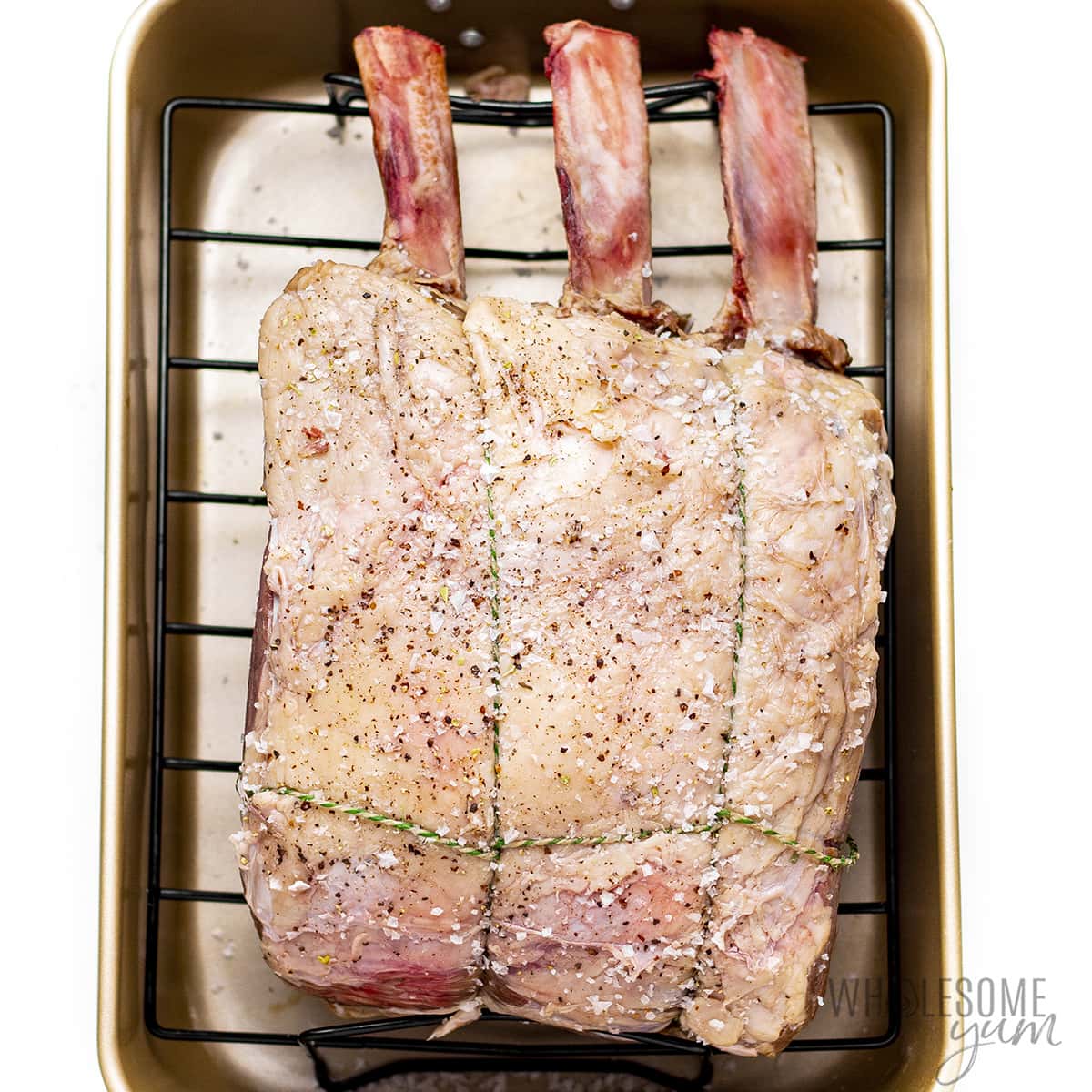
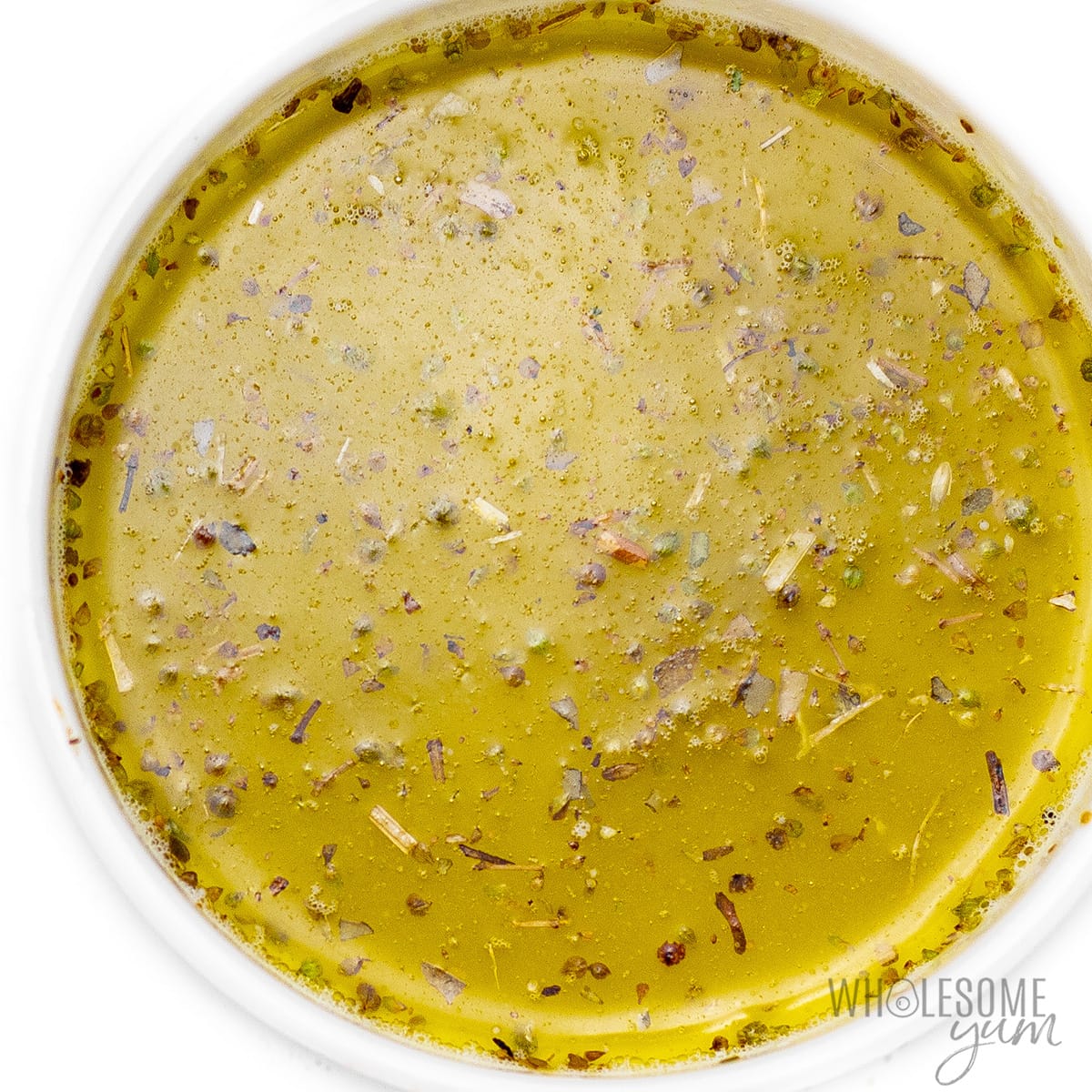
- Brush. Pour the mixture over the prime rib and use a basting brush to spread evenly.
- Roast. Cook prime rib in the oven, until the garlic on top is dark golden brown, but not burnt. Tent the top of the prime rib with foil. Reduce oven temperature and continue roasting until the prime rib reaches your desired internal temperature with a meat thermometer. (See the chart below for recommended times.)
- Rest. Remove the prime rib from the oven. Rest for 20 minutes before carving.
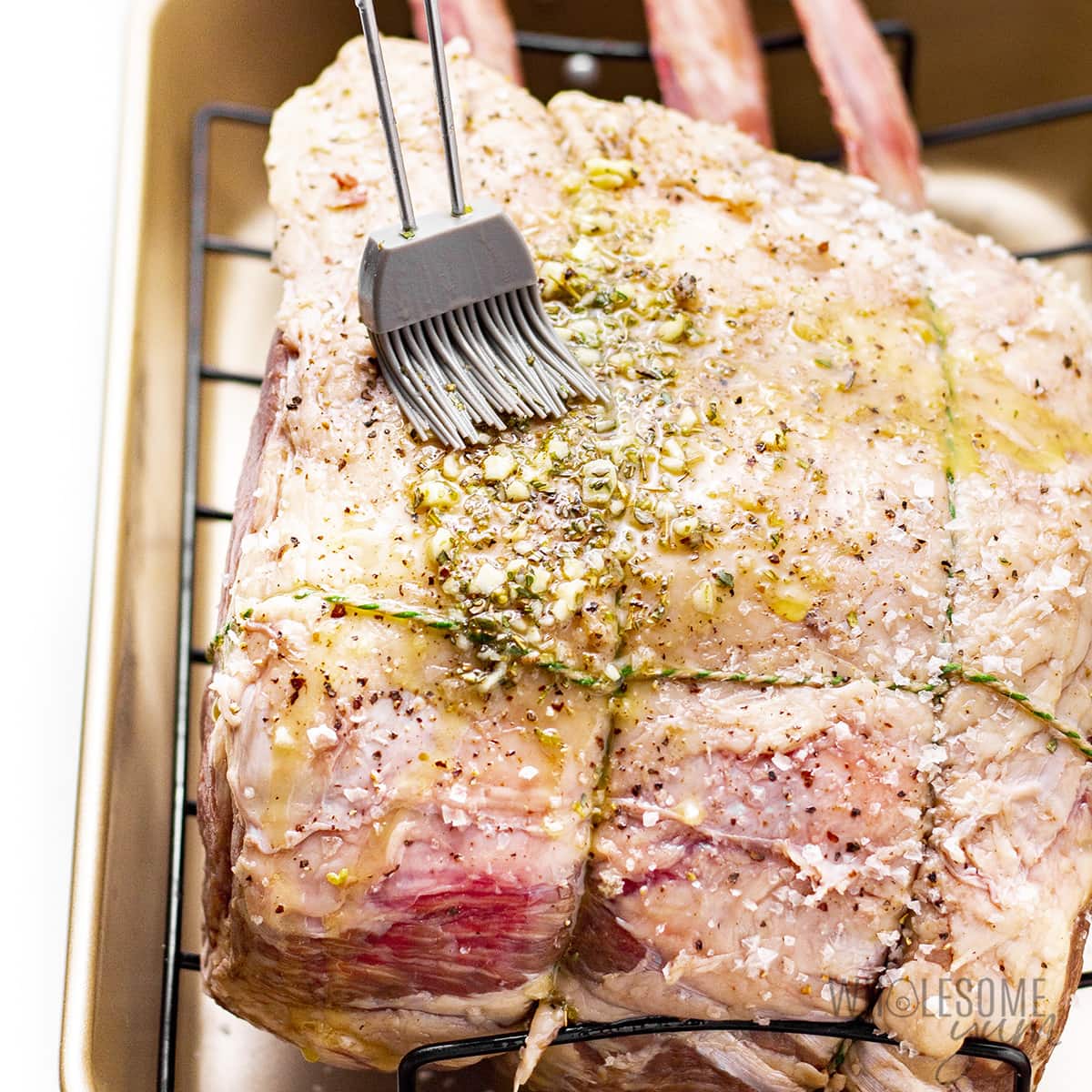
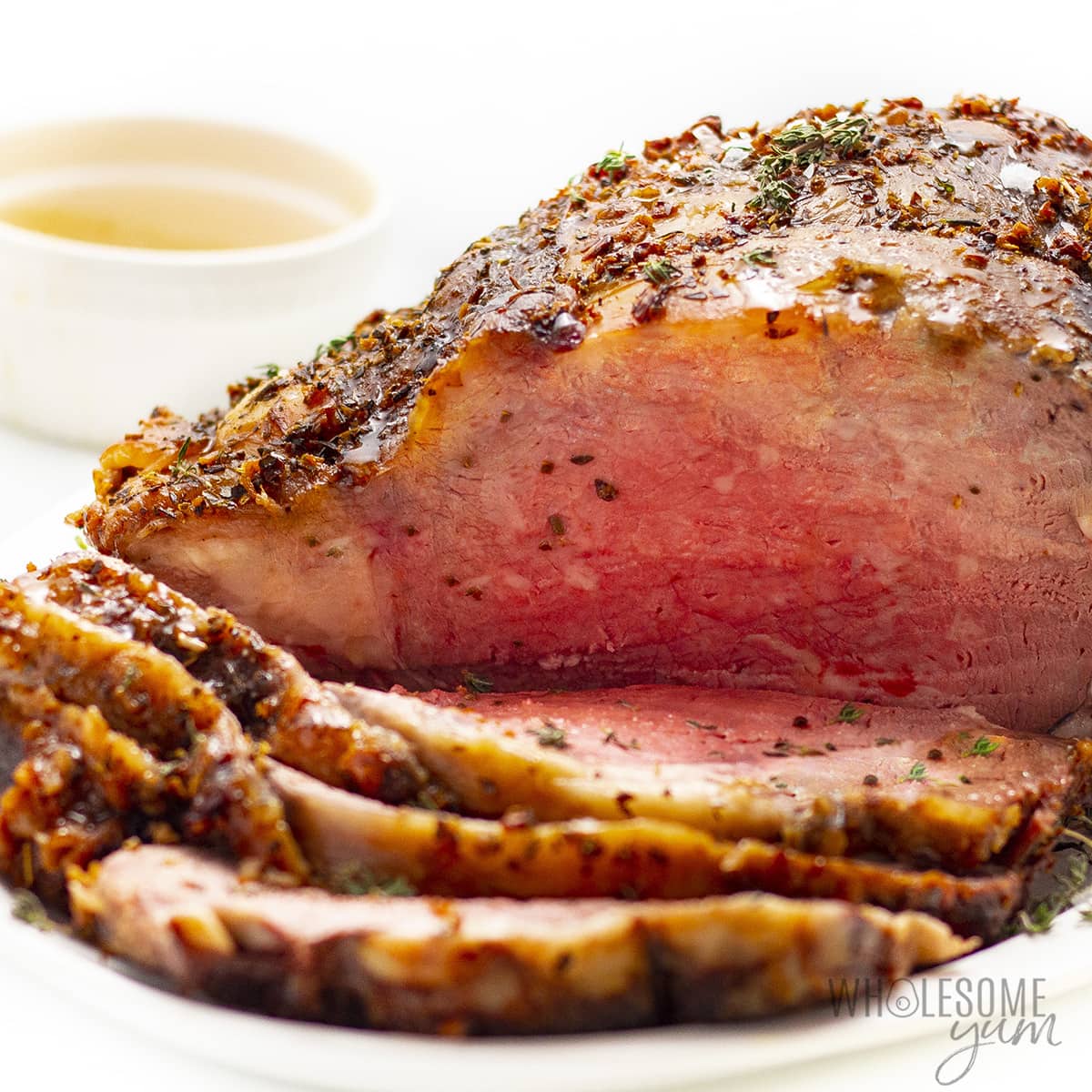
What Is The Right Prime Rib Temperature?
The ideal prime rib internal temperature is medium rare (135 degrees F), though some people prefer rare (125 degrees F) or medium (145 degrees F). However, because the temperature continues to rise when the meat rests after removing from the oven, stop cooking when the prime rib roast is 10 degrees below the doneness you want. Remove from the oven when it reaches 115 degrees F for rare, 125 degrees F for medium rare prime rib, or 135 degrees F for medium.
I don’t recommend cooking prime rib any further than medium, but if you like yours more medium-well, go ahead and cook it to suit your preference.
To achieve get a perfect brown crust but avoid burning, we use two different oven temperatures to cook this prime rib recipe:
- We start cooking prime rib at 450 degrees F, for about 20-30 minutes.
- Once the garlic is golden brown and the meat has browned, lower the temperature to 350 degrees F for the remaining cooking time.
How Long To Cook Prime Rib Roast?
When cooking prime rib, the time will vary depending on the size of the roast. To cook an 8-pound roast to medium rare, you will need to cook it for 20-30 minutes at 450 degrees, followed by 60-70 minutes at 350 degrees.
Even though cooking time for a perfect prime rib will depend on the weight and size of the prime rib roast, as well as how done you want your meat, I have some estimates here for you:
| Prime Rib Temperature | Minutes At 450°F (Step 1) | Then Minutes At 350°F (Step 2) |
|---|---|---|
| Rare | 20-30 minutes | 55-65 minutes |
| Medium Rare | 20-30 minutes | 60-70 minutes |
| Medium | 20-30 minutes | 65-80 minutes |
Important: The above meat temperatures are not final temperatures, just the temperature to reach in the oven. Internal temperature will rise another 20 degrees while the meat rests!
If your roast is a different size, it’s easy to adjust the prime rib cook time. To do this, multiply the actual weight by 15 (minutes per pound) and divide that number by 60 to get your approximate cooking time. Then, subtract the 20-30 minutes cooking time at 450 degrees F to get the remaining cook time. (If you don’t want to do math, just use a probe thermometer and it will beep when the right internal temperature is reached!)
Tips For The Best Prime Rib Recipe
Baking perfect prime rib is easy! When cooking bone-in prime rib, you want to pay attention to a few things:
- Tie the roast. This will ensure that your roast doesn’t spread, so it looks beautiful, but also the texture will be better.
- Don’t let your garlic burn. After the garlic is golden brown, it’s time to tent the prime rib. This is the best way to cook prime rib as it allows the meat to get nice and browned, but not burnt.
- Use a thermometer. When cooking prime rib roast in the oven, use a probe meat thermometer to track the internal temperature of the meat. This will vary based on oven temps and roast size, so it’s important to use a meat thermometer.
- Resting the meat is crucial (NOT optional!). Not only does resting the meat make it juicy, but it also allows the internal temperature to rise sufficiently.
How To Carve Prime Rib
I’ll admit, carving this bone-in prime rib recipe was a bit intimidating… but it’s actually not that difficult!
- Remove ribs. Stand the roast upright and cut between the bones and the meat.
- Slice. Slice the meat into thin, even slices. Try not to saw back and forth, so that the meat isn’t torn. Admittedly, I am not an expert at thinly slicing prime rib (much better at cooking it than slicing it, ha!), so let me know in the comments if you have a better way.
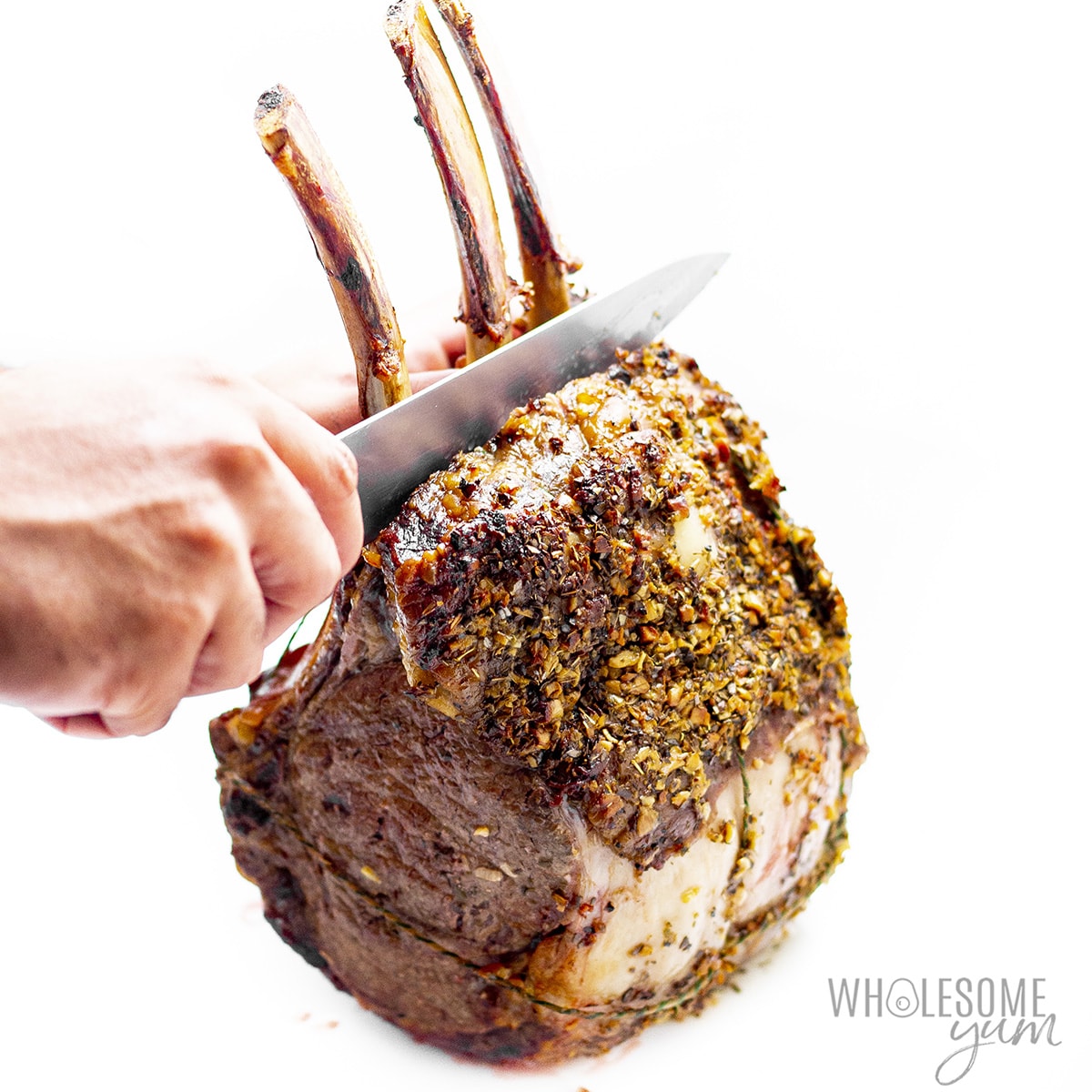
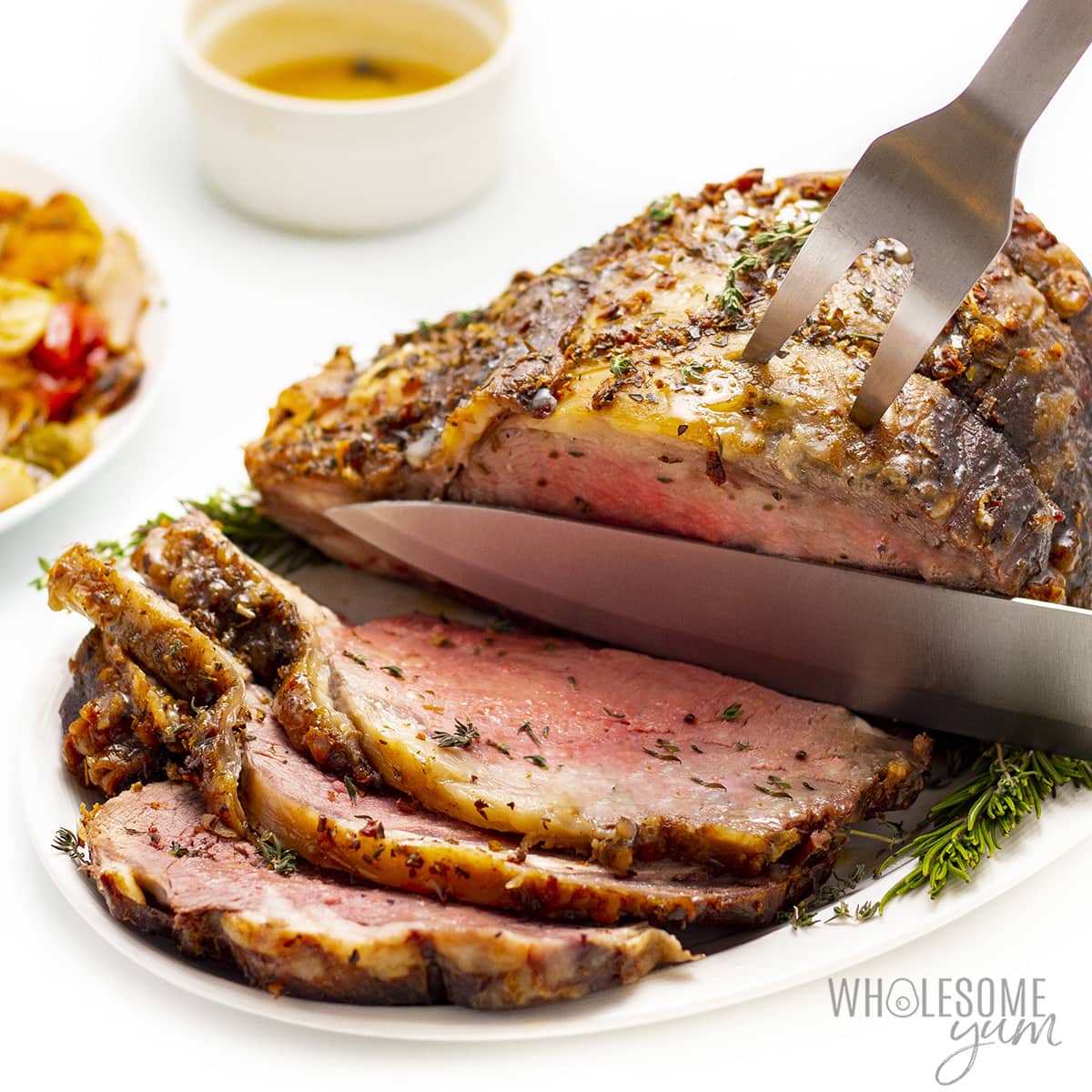
TIP: Only carve what you will eat right away.
If you have leftovers, keep the roast intact to keep the meat from drying out.
Storage Instructions
- Store: Wrap meat tightly in plastic wrap or aluminum foil. Store in the refrigerator for up to 3 days. Use leftovers in a spicy Thai beef salad or make a delicious prime rib sandwich with keto 90 second bread.
- Freeze: Cover tightly in freezer-safe wrap and store in the freezer for up to 6 months. Thaw in the refrigerator overnight before reheating.
How To Reheat Prime Rib
The best way to reheat prime rib is low and slow, so that you don’t dry out the meat. Place it in a roasting pan with saved juices from the pan (or beef broth) at the bottom, and cover with foil — this will keep the meat juicy. For slices of prime rib, reheat at 250 degrees F. For the whole roast, reheat at 350 degrees F. Check on it every 10 minutes and remove once it’s warm.
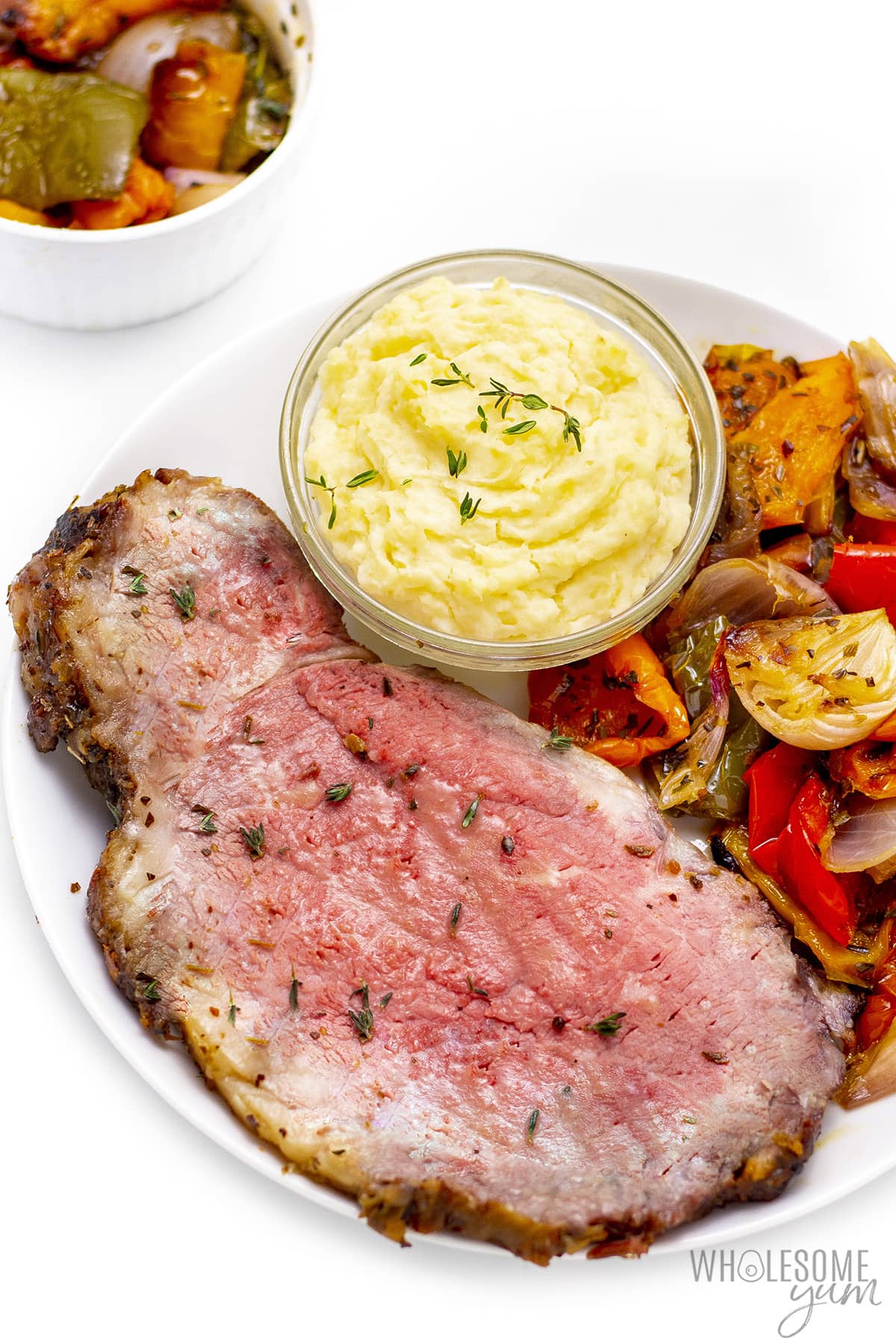
What To Serve With Prime Rib Recipes
Now that you know how to make slow-roasted prime rib recipe, it’s time to make some sides. Here are a few of my favorite side dishes:
More Special Occasion Recipes
It’s always nice to have a few special occasion recipes, like this roasted prime rib, up your sleeve. They’re the ones you can pull out when you want to make something extra-special for a birthday, anniversary, or holiday dinner. Here are a few of my favorites:
Prime Rib Roast Recipe (With Garlic Butter!)
Learn how to cook roasted prime rib perfectly every time! This prime rib roast recipe is melt-in-your-mouth tender, with just 10-minute prep.
Prep: 10 minutes
Cook: 1 hour 15 minutes
Resting Time 20 minutes
Total: 1 hour 45 minutes
Servings: 20 (adjust to scale recipe)
Convert:
Ingredients
Tap underlined ingredients to see where to get them. Please turn Safari reader mode OFF to view ingredients.
Instructions
Tap on the times in the instructions below to start a kitchen timer while you cook.
-
If your roast is not already tied (the butcher can usually do this for you), tie it tightly with kitchen twine. (This will prevent the meat from spreading as it cooks.)
-
Pat the roast dry with paper towels.
-
Place the prime rib, fatty side up, onto a roasting pan fitted with a roasting rack. Season liberally with sea salt and black pepper. Let it rest come to room temperature for 1 hour.
-
Preheat the oven to 450 degrees F (232 degrees C).
-
In a small bowl, stir together the butter, Italian seasoning, and minced garlic. Pour the mixture over the prime rib and use a basting brush to spread evenly.
-
Roast the prime rib in the oven, uncovered, for 20 to 30 minutes, until the garlic on top is dark golden brown, but not burnt. Tent the top of the prime rib with foil. Reduce oven temperature to 350 degrees F (176 degrees C) and continue roasting until the prime rib reaches your desired internal temperature:
* 110 F (43 C) for rare – approximately 55 to 65 minutes
* 115 F (46 C) for medium rare – approximately 60 to 70 minutes
* 125 F (51 C) for medium – approximately 65 to 80 minutes
For medium rare, it will take approximately an additional 8 to 9 minutes per pound of meat, at 350 degrees F (176 degrees C), after the initial high-temp roast at 450 degrees F (232 degrees C). The above meat temperatures are not final temperatures, just the temperature to reach in the oven. Internal temperature will rise another 10 degrees in the next step.
-
Remove the prime rib from the oven. Let it rest for an additional 20 minutes before carving, to come up to the right temperature and finish cooking.
Recipe Notes
Serving size: ~6.5 ounces, or approximately 1/20 of entire roast
Nutrition Facts
Amount per serving. Serving size in recipe notes above.
Calories 575
Fat 51g
Protein 24g
Total Carbs 0g
Net Carbs 0g
Fiber 0g
Sugar 0g
Nutrition facts are provided as a courtesy. Have questions about calculations or why you got a different result? Please see our nutrition policy.
© Copyright Maya Krampf for Wholesome Yum. Please DO NOT SCREENSHOT OR COPY/PASTE recipes to social media or websites. We’d LOVE for you to share a link with photo instead. 🙂
